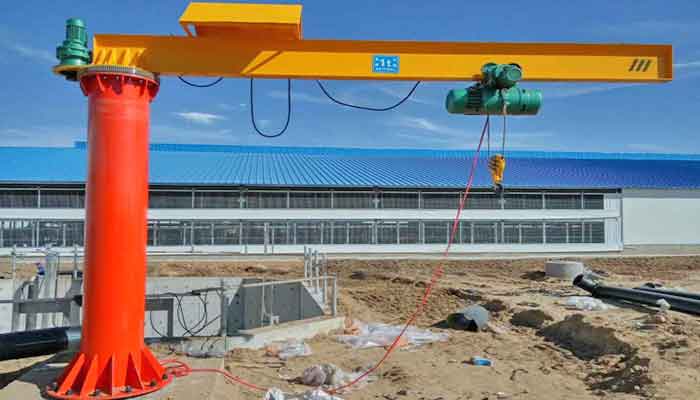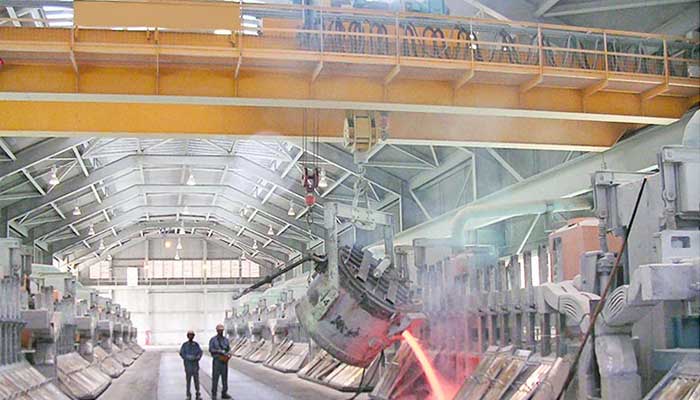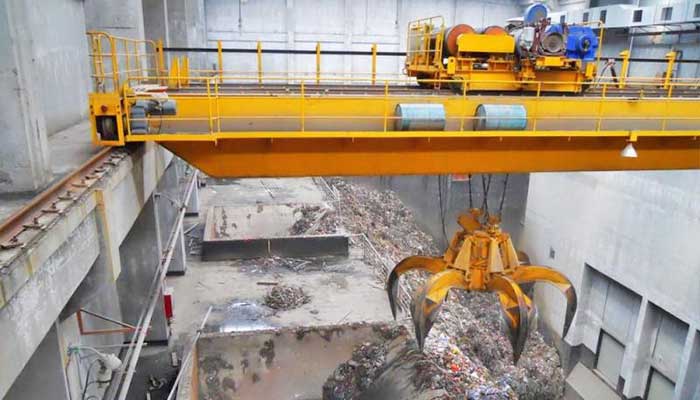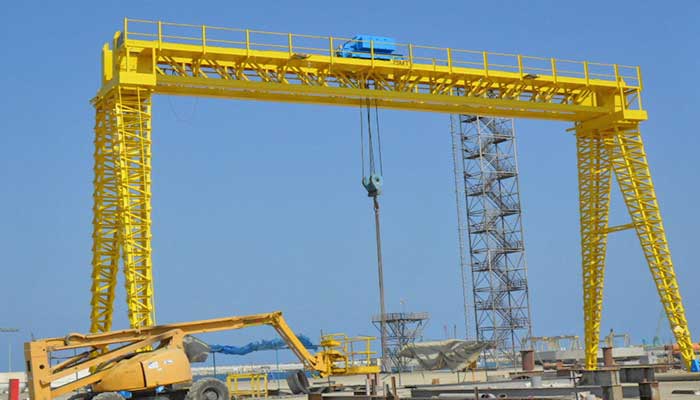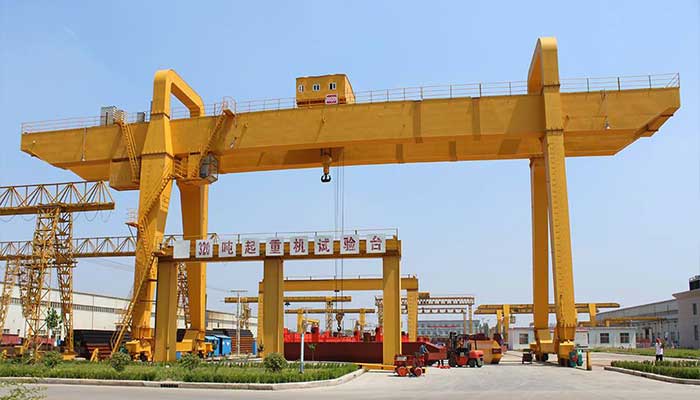
How to Ensure Overhead Crane Safety in Extreme Weather?
In a special and extreme weather condition with dust, humidity, high or cold temperature for the overhead crane, additional measures should be considered in addition to normal safety measures to adapt to the usage of the special environment and assure crane safety.
What factors affect ambient temperature of the crane?
Bridge cranes are an essential piece of mechanical equipment in road and bridge engineering and highway building. What elements influence the crane's ambient temperature?
- The radian should be regulated according to the planning requirements once the crane is installed. The top of the rail on both sides of the bridge constructing equipment's longitudinal running rail must be horizontally balanced.
- The front and rear outriggers' horizontal movement paths should be kept level, and the distance between them should be closely managed. The four tracks are in a straight line.
- The overuse of the overload lifting method has a bigger impact on the main beam's distortion.
- Improper bridge gas cutting repair and welding will result in a significant bending of the main girder. When switching railroads, be cautious.
- A welded construction, the box girder. The metal is locally heated during the welding process due to the influence of internal stress, resulting in metal expansion and contraction, resulting in residual force.
Internal stress will be increased as a result of an inefficient production process. Some main beam webs, for example, are not cut according to arch specifications, forcing the main beam arches to be cut by flame heating deformation or assembly welding.
Overhead crane in rain & humid weather
Rainy circumstances can damage your overhead crane even if lightning isn't present. Water can enter the crane through various parts including the clutch and brakes. Water can corrode these components, causing your crane to malfunction.
Overhead crane safety measures in raining & humid application
- Under normal circumstances, the working environment humidity is less than 85%, and the hoist crane's protection level is IP44, but due to an increase in the number of occasions where humidity exceeds 100%, such as at nuclear power plants where high-pressure water is used to flush nuclear equipment dust pollution, the heavy equipment's protection level must be increased.
- The hoist crane motor and electrical protection grade should be IP55 when the humidity is between 85% and 100%.
- In humid environments, a motor with a preheating and drying device of 10kW or more should be used.
- When using an electric hoist crane in the open, a rain cover should be used.
Jib crane for outdoor application with rainy cover
Overhead crane in heat application
Heat poses a risk to your overhead crane, even if it isn't as severe as cold weather. For one thing, heat can make your crane's seals less effective. Broken seals can lead to the failure of other components. As a result, especially in hot weather, it's critical not to expose your crane's seals to direct sunlight.
Overhead crane safety measures in high temperature environment
- A: An electrical fan or air conditioner should be installed in the operator cabin.
- B: The motor windings and cover should be constructed with a thermistor temperature control device, which will automatically shut down the motor if the temperature reaches a particular limit, or add powerful cooling measures (typically a special electric fan on the motor).
Overhead crane for high heat steel mill
Overhead crane in dust application
Another heat-related issue is dust, which collects frequently in hot weather. Dust and debris can wreak havoc with your crane if the filters aren't cleaned and maintained. It's also crucial to clean and lubricate the parts of your crane on a regular basis.
Under normal circumstances, operating an overhead crane can be risky. When harsh weather enters the picture, the danger factor increases. During extreme weather, follow these precautions to safeguard yourself, your staff, and your equipment.
Overhead crane safety measures in dust environment
When operating a hoist crane in a dusty environment, take the following crane safety precautions:
- A: To protect the driver's personal health, a fully enclosed cabin should be employed.
- B: The electrical protection level of the crane motor and the main electrical protection level should be upgraded accordingly; typically, hoist crane motors and electrical protection levels are IP44. The sealing performance should be raised in proportion to the size of the dust degree, for example, the protection (primarily dust capacity) level should be enhanced to IP54 or lP64.
Overhead crane for dusty waste handling
Overhead crane in cold weathrer
You generally don't think of chilly weather when you think of "severe weather." Cold weather, on the other hand, can have a significant impact on overhead cranes. The crane's tensile strength will be reduced in cold conditions, and it may potentially fail.
In cold weather, the hydraulic system of an overhead crane might become weakened. As a result, in subzero temperatures, you should reduce your load weight by 25%. Reduce the load weight by 40% if the temperature is below -20 degrees F.
Other cold-weather safety measures include:
- Surrounding the trolley with an enclosed track to protect it from ice
- Adding a cold weather finish to the crane
- Using conductor bars to protect the crane's joints
- Investing in a cold-weather motor
- Snow and extremely cold temperatures are dangerous conditions to operate a crane. You should exercise extreme caution under these conditions.
Overhead crane safety measures in cold environment
Each overhead crane has a wind rating that indicates the maximum wind speed it can withstand.Pay attention to how the wind impacts the crane at any given time while operating the crane in windy weather.
On the crane, proper safety precautions should be installed.
The following safety precautions should be taken when using a hoist crane in a chilly environment:
- If the operator cabin is closed, a heating device should be installed in the driver's quarters.
- Remove the ice from the ladder, track, or walkway as soon as possible.
- Low alloy steel or regular carbon steel with a hardness of not less than Q235-C (in - 20 DEG C) should be used.
Read more on Overhead Material Handling Crane Safety in Cold Weather.
Overhead gantry crane for cold weather
Overhead crane in wind weather
Wind is, without a doubt, the most hazardous weather condition for overhead cranes. The crane's load can swing due to the wind. This impact can place undue stress on the crane, potentially causing it to drop the weight.
Crane safety measures for windy application
- Each overhead crane has a wind rating that indicates the maximum wind speed it can withstand. Overhead cranes should not be used in gusts above 20 miles per hour, according to industry standards.
- Pay attention to how the wind impacts the crane at any given time while operating the crane in windy weather.
- Windproof anchor devices should be installed to ensure safety. Read More on Windproof Anchore Devices for Overhead Outdoor Gantry Crane.
Truss gantry crane for windy application
Tips for Operating a Crane in Extreme Weather Conditions
When operating a crane on a building site, inclement weather can be quite dangerous. Weather conditions such as high winds, rain, snow, and thunder and lightning make it dangerous to operate cranes for lifting activities. Unfortunately, depending on the nature of your job, you may not be able to take time off during inclement weather. How can you keep workers safe on the job without causing too much downtime? Here are some helpful hints for operating a crane in inclement weather without endangering people on the job.
Choose the right lifting crane for the weather
Cranes come in a variety of shapes and sizes, each ideal for a certain lifting task. Some are more stable than others, while others are capable of performing a wide range of activities. Finding the correct lifitng equipment for the task is the first step to successful rigging in extreme weather. For example, if you're working during a windy season, you should avoid employing overhead cranes that swing easily. Choose sturdier, more robust crane configurations instead.
Stay up-to-date with weather forecasts
Keep up with local weather forecasts on a daily and weekly basis to ensure this. For daily weather updates, visit the Department of Meteorology's website.
You can schedule your crane hire and rigging activities around the weather forecast for the next few days or weeks once you have that information. Lifting jobs should be done while the weather is mild to avoid being caught in harsh conditions. You can reschedule the task for another day if the forecast isn't accurate.
Evaluate safety protocols
Before each rigging operation, it's critical to assess safety standards to limit the risk. The following are some guidelines to follow:
Before each job, inspect cranes and rigging equipment.
To avoid crane overloading, use the load charts.
Before each lifting job, provide and inspect personal protective equipment (PPE) for the workers.
Remember to instruct all employees on how to work safely with and near cranes. Everyone on the jobsite, for example, should avoid working or strolling under a moving crane. To avoid danger if a weight falls off the rig, all workers should wear hard hats. To avoid erroneous operation, the crane should only be operated by an expert.
Prepare to terminate operations
Finally, rigging isn't something you do every day. Extreme weather operations can be dangerous. As a result, if all signs point to a hazardous work, it's preferable to call it a day and wait for the weather to improve. You should also be prepared to call off the job and protect the workers if the weather worsens during the operation. As a result, having a supervisor on-site to supervise the work is critical.
It's dangerous to operate a crane in bad weather. As a result, follow these guidelines to avoid injury and property damage. In you have any question or doubt, please feel free to contact us by leaving a message below.
